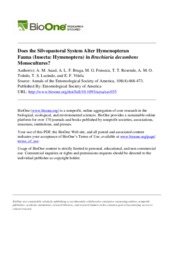Does the Silvopastoral System Alter Hymenopteran Fauna (Insecta: Hymenoptera) in Brachiaria decumbens Monocultures?
Does the Silvopastoral System Alter Hymenopteran Fauna (Insecta: Hymenoptera) in Brachiaria decumbens Monocultures?
Autoria: AUAD, A. M.; BRAGA, A. L. F.; FONSECA, M. G.; RESENDE, T. T. de; TOLEDO, A. M. O.; LUCINDO, T. S.; VILELA, E. F.
Resumo: The aim of this study was to evaluate whether environmental changes promoted by the conversion from a Brachiaria decumbens monoculture to a silvopastoral system can be measured by the diversity, richness, abundance, and constancy of insects of the order Hymenoptera. A Malaise trap for collecting insects was installed in a B. decumbens area managed as a silvopastoral system, and another was installed in a monoculture system. Hymenoptera richness and abundance were determined based on the number of morphospecies and specimens, respectively. The diversity and constancy indices were calculated using the Shannon?Wiener and Bodenheimer methodologies. Fifteen families of Hymenoptera were collected, seven of which were unique to the monoculture system. The samples from the silvopastoral system were significantly more abundant (3,889) and rich (305) compared with those from the monoculture system, which were much less abundant (1,473) and rich (173). Similar trends were noted for the families Formicidae, Ichneumonidae, and Braconidae. Additionally, these families and Sphecidae showed significantly greater diversity in the silvopastoral system. Formicidae and Braconidae were constant in both systems, while Ichneumonidae was constant only in the silvopastoral system. The families Vespidae, Pompilidae, and Apidae were more diverse; Chalcididae, Pompilidae, Sphecidae, Halictidae, Evaniidae, and Gasteruptiidae were more abundant; and Vespidae had more richness in the monoculture system. The conversion from the monoculture system to the silvopastoral system can be measured by the occurrence of Hymenoptera, especially the families Formicidae, Ichneumonidae, and Braconidae, which can be used as potential bioindicators.
Ano de publicação: 2015
Tipo de publicação: Artigo de periódico
Unidade: Embrapa Gado de Leite
Palavras-chave: Biological indicator, Brazil, Diversity, Insecta, Signal grass
Observações
1 - Por padrão são exibidas publicações dos últimos 20 anos. Para encontrar publicações mais antigas, configure o filtro ano de publicação, colocando o ano a partir do qual você deseja encontrar publicações. O filtro está na coluna da esquerda na busca acima.
2 - Para ler algumas publicações da Embrapa (apenas as que estão em formato ePub), é necessário ter, no celular ou computador, um desses softwares gratuitos. Sistemas Android: Google Play Livros; IOS: iBooks; Windows e Linux: software Calibre.
Acesse outras publicações
Acesse a Base de Dados da Pesquisa Agropecuária (BDPA) para consultar o acervo completo das bibliotecas da Embrapa.

